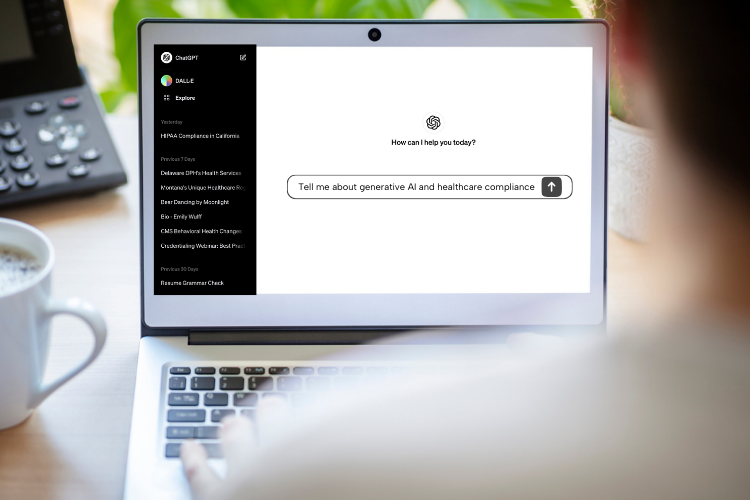Wait, really? Should healthcare compliance teams really use ChatGPT or other generative AI tools?
Sure — with caution, according to MedTrainer policy experts.
AI cannot replace a compliance expert in a healthcare organization. It’s not a magic bullet. It’s not a substitute for human knowledge, experience, or passion for compliance.
But, when used carefully, it can help you complete certain tasks faster and better.
Download Crash Course on Using AI for Healthcare Compliance Training for the best tips, prompts, and potential problems of using AI to create courses.
What Is Generative AI?
Generative AI is considered machine learning, meaning the technology can learn from data patterns to create new data (content) based on the data it was trained on. ChatGPT, created by OpenAI, is largely considered a turning point in the technology. The GPT stands for generative pre-trained transformer.
What Not To Do
Healthcare organizations are notorious for being slow adopters of technology. But it’s understandable – you’ve probably imagined all the things that could go wrong using generative AI. So you aren’t using it.
Maybe you just need to know how to use it.
The absolute first thing to remember is that YOU are critical. ChatGPT is not a regulatory or subject matter expert. You will still need to review and revise everything that comes from a chatbot – especially because the information they’re using is at least 12-18 months old. Healthcare moves fast – a lot can change in that time!
You will also need to be very specific in your prompts. Specify the exact regulations you need to follow and the exact output you’re looking for. Providing too few details will result in inconsistent, contradictory, and disorganized information.
Lastly, don’t rely on AI for all types of content. There are certain topics and projects that it will be a great help with (like the ideas listed below). There are others that will just result in much more work for you (it’s a bad idea to ask ChatGPT to write a training course on a nuanced, highly-regulated topics).
5 Ways to Use ChatGPT for Healthcare Compliance
1. Write Course Descriptions and Objectives
Generative AI gives you the best information, writing, and flow when you ask for it in smaller, bite-sized pieces. Since AI is not a subject matter expert or regulatory expert, asking it to write an entire course — or even a course module — will likely just result in more work for you. Instead, use ChatGPT for the smaller asks you often save for the end of a project, like writing the course description or objectives.
2. Make HIPAA Updates Fun
Keeping employee interest is tough when you’re talking about healthcare compliance. There are many ways to keep it interesting and generative AI can help you with a few more. For example, ask it to rewrite your email or poster copy in the style of a surfer from California. It will be gnarly! Or maybe try the style of a cowboy from old westerns. Howdy partner! ChatGPT can also help you to write game show-style questions, brain teasers, and more.
3. Conduct Research
Generative AI is a great starting point for research. As you’ve probably learned, in order for ChatGPT to be effective, it needs to be taught — and you need to be specific. Don’t hesitate to provide specific documents, URLs, and organizations where you want content from. You can also rephrase your commands to get different, or adjusted, results.
Here are some phrases you may want to include in your prompts:
- Cite sources in the text and include URLs at the end
- Only use information from websites ending in .gov, .edu, or .org
- Provide accurate and factual answers
- Use U.S. sources only
- Focus on [CITY/STATE]
4. Identify State-Specific Requirements
Determining state-specific requirements can be a tedious process if your organization has providers or facilities in multiple states. Generative AI is a good starting point for identifying regulations. As with the example above, you’ll want to specify the websites and documents that can be referenced.
5. Write Educational Case Scenarios
Using examples provides clarity and context, especially when dealing with complicated compliance topics. Generative AI is great for writing educational case scenarios. For example, you can write a prompt for sexual harassment scenarios along with the correct course of action. You can also use generative AI to write small snippets on specific subtopics within a law.
Deciding How To Move Forward With AI
Incorporating generative AI into certain parts of your compliance process will certainly reduce the time you’re spending. But, as you’ve likely realized, there is still a lot of double-checking, verifying, and tracking that needs to be done manually by a compliance expert.
If you want to use a generative AI tool to create compliance courses, you have to ask yourself if using a learning management system (LMS) is actually a better option. If you’re already using an LMS, but don’t have the healthcare-specific courses you need, maybe course licensing is the best option.
If you take the leap and begin using ChatGPT or another generative AI tool, be sure to keep in mind the potential pitfalls and areas where you may need to pay closer attention.

